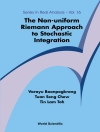Longitudinal data analysis for biomedical and behavioral
sciences
This innovative book sets forth and describes methods for the
analysis of longitudinaldata, emphasizing applications to problems
in the biomedical and behavioral sciences. Reflecting the growing
importance and use of longitudinal data across many areas of
research, the text is designed to help users of statistics better
analyze and understand this type of data.
Much of the material from the book grew out of a course taught by
Dr. Hedeker on longitudinal data analysis. The material is,
therefore, thoroughly classroom tested and includes a number of
features designed to help readers better understand and apply the
material. Statistical procedures featured within the text
include:
* Repeated measures analysis of variance
* Multivariate analysis of variance for repeated measures
* Random-effects regression models (RRM)
* Covariance-pattern models
* Generalized-estimating equations (GEE) models
* Generalizations of RRM and GEE for categorical outcomes
Practical in their approach, the authors emphasize the applications
of the methods, using real-world examples for illustration. Some
syntax examples are provided, although the authors do not generally
focus on software in this book. Several datasets and computer
syntax examples are posted on this title’s companion Web site. The
authors intend to keep the syntax examples current as new versions
of the software programs emerge.
This text is designed for both undergraduate and graduate courses
in longitudinal data analysis. Instructors can take advantage of
overheads and additional course materials available online for
adopters. Applied statisticians in biomedicine and the social
sciences can also use the book as a convenient reference.
表中的内容
Preface.
Acknowledgments.
Acronyms.
1. Introduction.
1.1 Advantages of Longitudinal Studies.
1.2 Challenges of Longitudinal Data Analysis.
1.3 Some General Notation.
1.4 Data Layout.
1.5 Analysis Considerations.
1.6 General Approaches.
1.7 The Simplest Longitudinal Analysis.
1.8 Summary.
2. ANOVA Approaches to Longitudinal Data.
2.1Single-Sample Repeated Measures ANOVA.
2.2 Multiple-Sample Repeated Measures ANOVA.
2.3 Illustration.
2.4 Summary.
3. MANOVA Approaches to Longitudinal Data.
3.1 Data Layout for ANOVA versus MANOVA.
3.2 MANOVA for Repeated Measurements.
3.3 MANOVA of Repeated Measures-s Sample Case.
3.4 Illustration.
3.5 Summary.
4. Mixed-Effects Regression Models for Continuous Outcomes.
4.1 Introduction.
4.2 A Simple Linear Regression Model.
4.3 Random Intercept MRM.
4.4 Random Intercept and Trend MRM.
4.5 Matrix Formulation.
4.6 Estimation .
4.7 Summary.
5. Mixed-Effects Polynomial Regression Models.
5.1 Introduction.
5.2 Curvilinear Trend Model.
5.3 Orthogonal Polynomials.
5.4 Summary.
6. Covariance Pattern Models.
6.1 Introduction.
6.2 Covariance Pattern Models.
6.3 Model Selection.
6.4 Example.
6.5 Summary.
7. Mixed Regression Models with Autocorrelated Errors.
7.1 Introduction.
7.2 MRMs with AC Errors.
7.3 Model Selection.
7.4 Example.
7.5 Summary.
8. Generalized Estimating Equations (GEE)Models.
8.1 Introduction.
8.2 Generalized Linear Models (GLMs).
8.3 Generalized Estimating Equations (GEE) Models.
8.4 GEE Estimation.
8.5 Example.
8.6 Summary.
9. Mixed-Effects Regression Models for Binary Outcomes.
9.1 Introduction.
9.2 Logistic Regression Model.
9.3 Probit Regression Models.
9.4 Threshold Concept.
9.5 Mixed-Effects Logistic Regression Model.
9.6 Estimation.
9.7 Illustration.
9.8 Summary.
10. Mixed-Effects Regression Models for Ordinal Outcomes.
10.1 Introduction.
10.2 Mixed-Effects Proportional Odds Model.
10.3 Psychiatric Example.
10.4 Health Services Research Example.
10.5 Summary.
11. Mixed-Effects Regression Models for Nominal Data.
11.1 Mixed-Effects Multinomial Regression Model.
11.2 Health Services Research Example.
1 1.3 Competing Risk Survival Models.
11.4 Summary.
12. Mixed-effects Regression Models for Counts.
12.1 Poisson Regression Model.
12.2 Modified Poisson Models.
12.3 The ZIP Model.
12.4 Mixed-Effects Models for Counts.
12.5 Illustration.
12.6 Summary.
13. Mixed-Effects Regression Models for Three-Level Data.
13.1 Three-Level Mixed-Effects Linear Regression Model.
13.1.1 Illustration.
13.2 Three-Level Mixed-Effects Nonlinear Regression Models.
13.3 Summary.
14. Missing Data in Longitudinal Studies.
14.1 Introduction.
14.2 Missing Data Mechanisms.
14.3 Models and Missing Data Mechanisms.
14.4 Testing MCAR.
14.5 Models for Nonignorable Missingness.
14.6 Summary.
Bibliography.
Topic Index.
关于作者
DONALD HEDEKER, PHD, is Professor of Biostatistics in the
Division of Epidemiology and Biostatistics, School of Public Health
at the University of Illinois at Chicago. He is a Fellow of the
American Statistical Association and the author of numerous
peer-reviewed papers.
ROBERT D. GIBBONS, PHD, is Director of the Center for
Health Statistics; Professor of Biostatistics in the Division of
Epidemiology and Biostatistics, School of Public Health; and
Professor of Psychiatry in the College of Medicine, all at the
University of Illinois at Chicago. He is a Fellow of the American
Statistical Association and the author of numerous peer-reviewed
papers.












